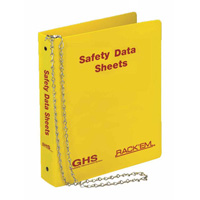| The Home page of ILPI's Safety Data Sheet (SDS) Resource, the leader in SDS information since 1995! | |
| The history and philosophy behind this resource. | |
| A curated collection of books and reference materials concerning Safety Data Sheets and closely related topics. | |
| Paste your plain text SDS into the SDS-Demystifier, and it will be converted into a hypertext-enriched document with links to detailed explanations of each key term. | |
| An extensive list of frequently asked questions about Safety Data Sheets including regulations, content, compliance, and more. | |
| A humorous take on Safety Data Sheet jargon. Fill in the blanks on our entry form to generate a personalized Unsafety Data Sheet to share with your coworkers. | |
| Since 1995, we've maintained this massive curated list of the best places to find Safety Data Sheets on the Internet. | |
| You are here! Way more than a glossary, this hypertext-enhanced resource covers hundreds of SDS-related terms and expert knowledge. Each entry includes both the SDS relevance and links to additional authoritative resources. | |
| Archived results of Safety Data Sheet related polls taken by some of our millions of site visitors | |
| The OSHA regulations behind SDS regulations, including the inspection guidelines and over 400 official interpretations letters under the Hazard Communication Standard | |
| Commercial suppliers of SDS authoring and management software as well as cloud compliance services. | |
| Commercial companies that will create SDS's for your specific needs as well as SDS translation companies. |

Safety signs, banners, and scoreboards? Get yours at Safety Emporium!

Get your SDS binders, centers and more from Safety Emporium.
Definition
- Decomposition is the breakdown or change of a material or substance (by heat, chemical reaction, or other processes) into other chemical compounds.
- Thermal decomposition is decomposition initiated by heating.
- Chemical decomposition is decomposition induced by the addition of one or more chemicals to a substance.
Additional Info
Just as a piece of food (which is really just a collection of many chemicals) can spoil or rot (see biodegradable), so can certain chemical substances or mixtures.
For example, when glucose (a form of sugar) is burned in air, it decomposes into carbon dioxide and water. This reaction is also an example of an exothermic combustion reaction:

See this discussion of thermodynamics for more information about the energy involved in this and other reactions.
Living organisms exploit decomposition reactions in order to live. For example, the digestion of food is an exothermic process, which provides organisms with heat and chemical energy while converting the food to simpler substances that are then used as building blocks within the body or are discarded as waste.
As we live in a dynamic world, many of the everyday objects around us are thermodynamically unstable. Provided the conditions are right, they will decompose all by themselves or with a little help by Nature. Examples include bread, nitroglycerin, lawn clippings and more. Some of these processes generate enough heat on their own to undergo spontaneous combustion!
Certain classes of chemicals such as peroxides, pyrophoric and water-reactive materials can decompose quite readily, releasing so much heat that they can explode or combust. These highly-reactive materials pose serious hazards and should only be handled by experts.
SDS Relevance
The OSHA Hazard Communication Standard (HCS) requires the decomposition temperature to be reported in Section 9 of the Safety Data Sheet and any hazardous decomposition products to be reported in Section 10.
Decomposition can have many effects, each of which is potentially hazardous:
- New substances may be formed, some or all of which are explosive, flammable or toxic. Peroxide-forming materials are particularly dangerous.
- Decomposition may result in the release of a large amount of heat, possibly resulting in a fire or explosion. The phrase "explosive decomposition" may appear on the Safety Data Sheet (SDS).
- Partial decomposition can introduce toxins or other unstable materials as well as degrade the physical properties of the material.
- Spontaneous polymerization of the material may occur, changing an easily handled liquid into an insoluble solid (see the BP Amoco case under Further Reading, below). The phrases "self-polymerize" or "auto-polymerize" may appear on the SDS in the storage and transport sections. Some polymerizations may be autocatalytic, meaning that the heat they generate causes the polymerization to accelerate, possibly resulting in an explosive decomposition.
Further Reading

Keep your reactions together with these Keck-style standard taper joint clips from Safety Emporium.
- The American Chemical Society's journal Chemical & Engineering News maintains a list of Safety Letters concerning materials involved in unexpected explosive decompositions.
- The UK's Health & Safety Directorate has a comprehensive guide to chemical warehouses which includes a discussion of decompositions.
- Examples of violent self-polymerization reactions at Aristatek, courtesy of the Internet Wayback Machine.
- Hazard Analysis: The BP Amoco Thermal Decomposition Incident at Space Safety.
- A list of shock sensitive chemicals courtesy of DePauw U Environmental Health & Safety.
See also: HMIS, incompatible chemicals, peroxide, polymerization.